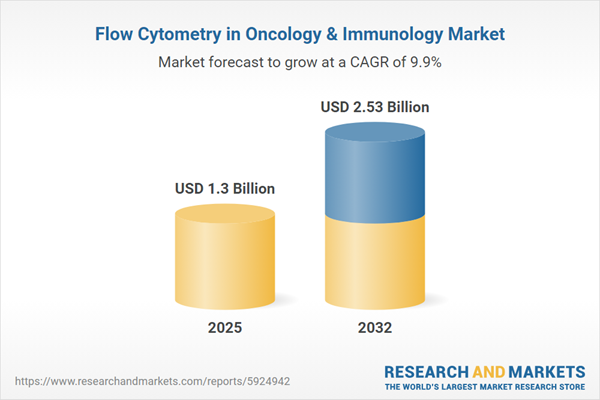Speak directly to the analyst to clarify any post sales queries you may have.
Flow cytometry continues to play a transformative role in laboratory management and precision medicine, enabling senior decision-makers to increase diagnostic accuracy, improve adaptability, and optimize research efficiency in ever-evolving oncology and immunology settings.
Market Snapshot: Flow Cytometry in Oncology & Immunology
The Flow Cytometry in Oncology & Immunology Market is sustaining robust growth, reaching a valuation of USD 1.18 billion in 2024 with expected expansion to USD 1.30 billion by 2025. A strong compound annual growth rate of 9.91% underscores ongoing investment, with organizational priorities moving toward integrated diagnostic workflows, expanding cell therapy initiatives, and flexible detection solutions. This evolving market landscape reflects the industry’s commitment to scalable, innovative cellular analysis strategies that match the demands of both laboratory and clinical leaders. Investments in platform interoperability and workflow automation are streamlining diagnostic precision and enhancing research output across diverse settings.
Scope & Segmentation of the Flow Cytometry Market
This report provides comprehensive segmentation to support effective market planning, maximize competitive positioning, and unlock operational efficiencies. Executive teams will benefit from detailed insights across the following dimensions:
- Product Types: Benchtop analyzers enhance daily laboratory throughput; high-throughput analyzers enable advanced analytical tasks in research environments; microfluidic sorters provide accurate cell isolation for specialized assays; standardized calibration beads support assay reliability; assay kits enable streamlined protocols; durable sample plates facilitate study scalability; and customized antibodies help address unique research challenges.
- Technology: Conventional two-color and multicolor flow cytometry solutions cater to essential laboratory analysis; imaging flow cytometry expands capabilities in molecular profiling; mass cytometry supports complex diagnostics and high-capacity testing.
- Applications: Key applications cover immuno-oncology research, CAR T therapy advancement, dendritic cell study support, expanded clinical diagnostics, and integration of new immunotherapy approaches in both research and care delivery.
- End Users: Primary stakeholders include academic research organizations conducting foundational and advanced studies; contract research organizations providing adaptable services; hospital systems deploying advanced diagnostics; pharmaceutical and biotechnology companies accelerating discovery; and laboratories aiming for enhanced operational performance.
- Regional Coverage: Market traction is notable across the Americas, Europe, Middle East, Africa, and Asia-Pacific. Activity clusters in the United States, Germany, China, and India reflect key regional drivers such as compliance frameworks, speed of technology adoption, and overall market maturity.
- Key Companies: Prominent organizations shaping the competitive landscape include Becton, Dickinson and Company, Thermo Fisher Scientific Inc., Danaher Corporation, Merck KGaA, Sysmex Corporation, Bio-Rad Laboratories, Agilent Technologies, Miltenyi Biotec GmbH, Sony Biotechnology Inc., and Cytek Biosciences Inc. Strategic priorities across these participants focus on compliance, innovation, and fostering collaborative scientific networks.
Key Takeaways for Senior Decision-Makers
- Technological enhancements in flow cytometry are enabling organizations to refine operational workflows, resulting in elevated research output and greater diagnostics efficiency in both clinical and laboratory environments.
- Integrating imaging and mass cytometry technologies is advancing biomarker research and accelerating the transformation of laboratory results into actionable clinical strategies for immunotherapy.
- Availability of custom assay and reagent solutions offers flexibility for precise diagnostics, empowering teams to progress precision medicine initiatives while supporting organization-specific goals.
- Extensive workflow automation, modular system design, and AI-enabled analytics are strengthening process reliability, boosting consistency, and increasing scalability to meet the evolving needs of laboratory leaders.
- Collaboration among academic, regulatory, and commercial partners is critical for effective procurement, compliance management, and maintaining operational resilience as market conditions shift.
Tariff Impact and Supply Chain Adaptation
In response to recent U.S. tariff changes affecting core flow cytometry equipment, industry participants are prioritizing diverse supplier relationships, engaging in bulk purchasing, and optimizing global sourcing to mitigate cost pressures. These proactive measures help preserve supply chain continuity and ensure that laboratories experience minimal disruption in daily operations.
Methodology & Data Sources
This analysis is built on direct input from experienced executives, laboratory managers, and key market participants. All findings are validated against up-to-date scientific criteria and regulatory guidelines to ensure they support reliable decision-making for technology adoption and investment in the flow cytometry market.
Why This Report Matters
- Equips executive leadership with actionable market segmentation and timely trend analysis to inform strategic resource planning in a dynamic environment.
- Enables benchmarking, supports region-specific initiatives, and aids in procurement planning during organizational transitions.
- Guides seamless technology adoption and compliance management to maintain flexibility as partnership dynamics or regulatory expectations evolve.
Conclusion
Flow cytometry remains a critical asset in advancing oncology and immunology management, supporting consistent performance and expanding capabilities for both research and clinical teams.
Additional Product Information:
- Purchase of this report includes 1 year online access with quarterly updates.
- This report can be updated on request. Please contact our Customer Experience team using the Ask a Question widget on our website.
Table of Contents
3. Executive Summary
4. Market Overview
7. Cumulative Impact of Artificial Intelligence 2025
Companies Mentioned
The companies profiled in this Flow Cytometry in Oncology & Immunology market report include:- Becton, Dickinson and Company
- Thermo Fisher Scientific Inc.
- Danaher Corporation
- Merck KGaA
- Sysmex Corporation
- Bio-Rad Laboratories, Inc.
- Agilent Technologies, Inc.
- Miltenyi Biotec GmbH
- Sony Biotechnology Inc.
- Cytek Biosciences Inc.
Table Information
| Report Attribute | Details |
|---|---|
| No. of Pages | 192 |
| Published | November 2025 |
| Forecast Period | 2025 - 2032 |
| Estimated Market Value ( USD | $ 1.3 Billion |
| Forecasted Market Value ( USD | $ 2.53 Billion |
| Compound Annual Growth Rate | 9.9% |
| Regions Covered | Global |
| No. of Companies Mentioned | 11 |









